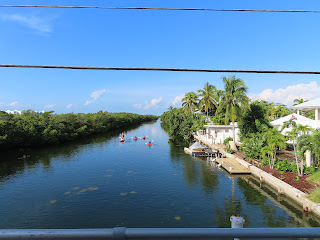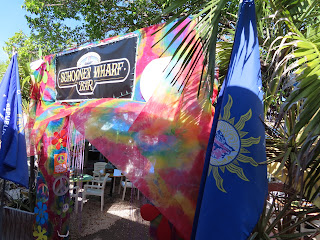Day 2 of our Yankee RV Key West Fiesta Rally started with a Continental
Breakfast at the campground, provided by Yankee RV.
Our breakfast was followed by a private Trolley Tour of Key
West. The Trolley picked us up at campground and we began our tour. Since it
was a private trolley ride, our driver, Pam, did not have to follow the
standard trolley route.
At the end of Stock Island, we crossed Cow Key
Channel, the channel that separates Stock Island from Key West. Once on Key
West, we went over the Riviera Canal with the Red Mangroves and the salt ponds
on the right. The Salt Ponds were constructed for the manufacturing of salt
during the 1830s, the Key West Salt Ponds once covered a hundred acres of
man-made shallow pans carved into the coral rock of the island. Suspended
during the Civil War and abandoned several times, the commercial salt-making
operation ended by 1906. Meacham Field, the first runway on Key West, was built
atop the salt ponds in the 1920s, when Pan American Airlines began flying. It
eventually became the Key West International Airport. Everyone thinks the
Atlantic Ocean is on the left, but it is really the Straits of Florida.
Since we are just a few days after a special holiday
in Key West. Pam, our Trolley driver, had to show us the locations of the great
Halloween decorations.
Visitors to Key West’s Higgs Beach might not pay
much attention to the small rectangle of beachfront fenced off from the rest
and flanked by tall columns. If it wasn’t for our trolley driver, we would have
missed it too. It is the only African refugee cemetery in the United States. The
cemetery’s importance was recognized in 2012 when it was listed on the National
Register of Historic Places as a nationally significant archaeological site.
The graves are the Africans who died in 1860 after
being freed by the US Navy from three American-owned slave ships captured near
the Cuban coast and brought to Key West for sanctuary. According to records
kept by US Marshal Fernando Moreno in 1860, more than 1,400 African men, women
and children were transported to Key West after being rescued from the slave
vessels. Key West workers quickly built housing and a hospital for them. While
most of the refugees were eventually returned to Africa, 295 died at Key West,
most likely from illnesses resulting from the brutal conditions aboard the
slave ships. They were buried in unmarked graves along the island’s southern
shore.
 Today, the cemetery is marked by a series of pedestals adorned with African Adinkra symbols and topped with engraved bronze plaques. A concrete base features a rendition of the slave trade’s maritime route, while a tile mural is inlaid into the platform riser and ornamental fencing encloses the site on three sides. These elements combine to reflect the cultures of the people buried in the cemetery and how they came to be so far from home.
Today, the cemetery is marked by a series of pedestals adorned with African Adinkra symbols and topped with engraved bronze plaques. A concrete base features a rendition of the slave trade’s maritime route, while a tile mural is inlaid into the platform riser and ornamental fencing encloses the site on three sides. These elements combine to reflect the cultures of the people buried in the cemetery and how they came to be so far from home.
The current lighthouse opened in 1848 with a woman as
its keeper, nearly unheard of during the 19th century. In 1969, the
US Coast Guard decommissioned the Key West Lighthouse since there was no longer
a need for a full-time keeper due to technological advancements. Today, the
sentinel of the sea stands as a museum dedicated to Key West’s maritime
heritage and to the men and women who bravely kept the light burning through
the threats of war and weather. We took the 88 steps to the top, last time we
were in Key West.
US Route 1 ends or begins, depending on your perspective,
at the intersection of Whitehead and Fleming Streets in Key West. It is a 2,369
miles to or from its northern terminus in Fort Kent, Maine.
The Tropic Cinema opened its doors in Old Town Key
West in 2004. They wanted to bring quality movies to people who longed for
something more than Hollywood blockbusters. What started as a small, two-screen
nonprofit theater quickly expanded to a four-screen multiplex with
state-of-the-art digital projection, an art gallery, extensive concessions, and
a lounge. It boasts a modern Art Deco design to represent the best of both Old
Hollywood and contemporary cinema.
The famous picture of Marilyn Monroe laughing as her
skirt is blown up by the blast from a subway vent was shot on September 15th,
1954 filming The Seven Year Itch. The scene infuriated her husband, Yankee
legend Joe DiMaggio, who felt it was exhibitionist and divorced her shortly
after. You can find this Marilyn Monroe life-like statue in front of the Tropic
Cinema.
Of course, I had to share the purple Artist’s house
with you. It is a historic Victorian Guesthouse. The world famous Artist House
is one of the most photographed houses in Key West and the former home of
Robert the Doll. The Artist House has been operating as an island favorite
since 1978. They are one of the oldest continually operating guest houses in
Key West.
BO’s Fish Wagon includes a funky sticker covered
truck outside the restaurant - which is a driftwood shack doling out fried
fish, conch fritters & fast food. The owner, Buddy Owen, is something of a
local legend, having started his operation more than 25 years ago out of a
little wagon on Duval Street. Last year, Bobby Flay and his Food Network camera
crew paid a visit.
Marine artists Wyland & Guy Harvey teamed up to
repaint the faded Wyland mural on Key West’s former Waterfront Market, now home
to a craft brewery. Wyland has painted many of these murals though out the
world in hopes of raising awareness and appreciation of the ocean, this mural
was number 52 of his more than 100 murals. This mural is known as Wyland’s
Whaling Wall.
Schooner Wharf was originally located on the Schooner
Diamante, the bar moved ashore, where the top shelf liquor was kept in the top
drawer of a filing cabinet! The bar has evolved into a very special place over
the years. It has expanded into a neighboring building and added a second-floor
deck with a beautiful view of the classic yachts of Key West's Historic Seaport.
Voted Best Local's Bar six years in a row, the
Schooner Wharf has been acclaimed in such diverse publications as the New York
Times, and Aqua magazine, for its unique nautical decor, music and food, and
open-air proximity to sweet ocean breezes. Fresh stone crab claws, peel-and-eat
shrimp, fresh-shucked oysters, and, of course, conch chowder and fritters, are
among the local seafood delicacies on the menu in the galley. Chicken wings,
eight-ounce burgers, and juicy steak sandwiches are always on hand for the
land-lubber.
The chickens, roosters and baby chicks are all protected on Key West and they are everywhere! But they are so cute!
In Mallory Square Marketplace, there are ample metal
birds … but none of Maudine’s kin. She came from Key West and she was really
hoping to see some of her family!
Since 1890, history has left its mark on the Truman
Little White House. Initially, it served as the naval station’s command
headquarters during the Spanish-American War, World War I and World War II. In
1946 the historic building first served as the winter White House of President
Harry S. Truman and a site for the Cold War response by later presidents.
Today, the Truman Little White House is a public,
living, Key West museum as well as a retreat and place of government business
by our nation's leaders. We enjoyed an almost private tour with Maxine and one
other guest … that is pretty private! Since it is still considered an active
Presidential home, we were not allowed to take pictures inside. But, I will
tell you that it has an awesome history and a well worth stop when you are
here!
All around the Truman Little White House is private
housing and the old Naval Annex that has been converted into condominiums. It
was a quiet place to walk back toward Mallory Square and the Trolley depot for
our ride back to the campground.
Originally home to the island’s customs office,
postal service and district courts. This four-story architectural marvel was
built to keep pace with the increasing population and wealth accumulating from
Key West’s lucrative trade routes and maritime industries. The imposing structure
is a tremendous example of Richardson Romanesque architecture which was typical
for federal buildings projects near the end of the 19th century.
Positioned adjacent to the US Naval base, the Custom
House was the site of many significant historical events, most notably the inquiry
into the sinking of the USS Maine in Havana Harbor in 1898. Today, “Old 91” has
been fully restored and stands on the harbor as a national landmark, an award-winning
museum and official headquarters of the Key West Art & Historical Society.
The trolley took us back to the campground and some
of us re-grouped for an evening meal at Roostica, a wood-fired kitchen.
There were 12 of us that had a cozy meal at
a long table.
What a better way to get to know the other rally goers!
Some ordered the wood-fired pizza, salads, lasagna,
calzone and chicken parmesan.




























No comments:
Post a Comment